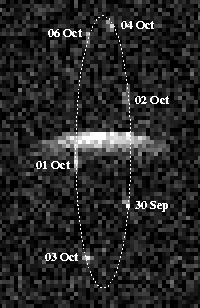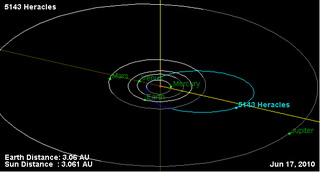Related Research Articles

1620 Geographos, provisional designation 1951 RA, is a highly elongated, stony asteroid, near-Earth object and potentially hazardous asteroid of the Apollo group, with a mean-diameter of approximately 2.5 km (1.6 mi). It was discovered on 14 September 1951, by astronomers Albert George Wilson and Rudolph Minkowski at the Palomar Observatory in California, United States. The asteroid was named in honor of the National Geographic Society.
4031 Mueller, provisional designation 1985 CL, is a Hungaria asteroid from the inner regions of the asteroid belt, approximately 4 kilometers in diameter. It was discovered on 12 February 1985, by American astronomer Carolyn Shoemaker at Palomar Observatory, California, and named after astronomer Jean Mueller.
1123 Shapleya, provisional designation 1928 ST, is a stony Florian asteroid from the inner regions of the asteroid belt, approximately 11 kilometers in diameter. It was discovered on 21 September 1928, by Russian astronomer Grigory Neujmin at Simeiz Observatory on the Crimean peninsula. It was named after American astronomer Harlow Shapley.
1151 Ithaka, provisional designation 1929 RK, is a carbonaceous asteroid from the inner regions of the asteroid belt, approximately 14 kilometers in diameter. It was discovered by Karl Reinmuth at the Heidelberg-Königstuhl State Observatory in 1929, and later named for the Greek island of Ithaca.

(185851) 2000 DP107 is a sub-kilometer sized asteroid, classified as potentially hazardous asteroid and near-Earth object of the Apollo group that is notable because it provided evidence for binary asteroids in the near-Earth population. The PROCYON probe developed by JAXA and the University of Tokyo was intended to flyby this asteroid before its ion thruster failed and could not be restarted.
1394 Algoa, provisional designation 1936 LK, is a stony asteroid from the inner regions of the asteroid belt, approximately 14 kilometers in diameter. It was discovered on 12 June 1936, by English-born South-African astronomer Cyril Jackson at Union Observatory in Johannesburg, South Africa. The asteroid was named after the historical Algoa Bay.
6042 Cheshirecat ( or ), provisional designation 1990 WW2, is an eccentric, rare-type asteroid and large Mars-crosser from the outer regions of the asteroid belt, approximately 14 kilometers in diameter. It was discovered by Japanese astronomers Akira Natori and Takeshi Urata at the JCPM Yakiimo Station on 23 November 1990. It was named for the Cheshire Cat from the novel Alice's Adventures in Wonderland.
1919 Clemence, provisional designation 1971 SA, is a bright Hungaria asteroid and suspected tumbler from the inner regions of the asteroid belt, approximately 4 kilometers in diameter. It was discovered on 16 September 1971, by American astronomer James Gibson together with Argentine astronomer Carlos Cesco at the Yale-Columbia Southern Station at Leoncito Astronomical Complex in Argentina. It is named after astronomer Gerald Clemence.

5143 Heracles, provisional designation 1991 VL, is a highly eccentric, rare-type asteroid and synchronous binary system, classified as near-Earth object of the Apollo group, approximately 4.8 kilometers in diameter. The asteroid was discovered on 7 November 1991, by American astronomer Carolyn Shoemaker at Palomar Observatory in California, United States. It is named for the Greek divine hero Heracles. It has an Earth minimum orbit intersection distance of 0.058 AU (8.7 million km) and is associated with the Beta Taurids daytime meteor shower.

1985 Hopmann is a dark background asteroid in the outer regions of the asteroid belt. It was discovered on 13 January 1929, by astronomer Karl Reinmuth at Landessternwarte Heidelberg-Königstuhl in southern Germany. The asteroid has a rotation period of 17.5 hours and measures approximately 36 kilometers in diameter. It was later named after German astronomer Josef Hopmann (1890–1975).
4868 Knushevia, provisional designation 1989 UN2 is a bright Hungaria asteroid and suspected binary system from the innermost regions of the asteroid belt, approximately 2 kilometers in diameter. It was discovered on 27 October 1989, by American astronomer Eleanor Helin at the Palomar Observatory in California, United States. The asteroid was named for the Kyiv University in Ukraine.
6500 Kodaira, provisional designation 1993 ET, is a highly eccentric, rare-type asteroid and sizable Mars-crosser from the central regions of the asteroid belt, approximately 10 kilometers in diameter. It was discovered on 15 March 1993, by Japanese amateur astronomers Kin Endate and Kazuro Watanabe at Kitami Observatory in eastern Hokkaidō, Japan. It was named for Japanese astronomer Keiichi Kodaira.
1951 Lick, provisional designation 1949 OA, is a rare-type asteroid and Mars-crosser, approximately 5.6 kilometers in diameter. It was discovered on 26 July 1949, by American astronomer Carl Wirtanen at Lick Observatory on the summit of Mount Hamilton, California, and named for American philanthropist James Lick.
4708 Polydoros is a Jupiter trojan from the Trojan camp, approximately 55 kilometers in diameter. It was discovered on 11 September 1988, by American astronomer Carolyn Shoemaker at the Palomar Observatory in California. The D-type asteroid belongs to the 80 largest Jupiter trojans and has a rotation period of 7.5 hours. It was named after the Trojan prince Polydorus, from Greek mythology.
1359 Prieska, provisional designation 1935 OC, is a rare-type carbonaceous asteroid from the outer region of the asteroid belt, approximately 50 kilometers in diameter. It was discovered on 22 July 1935, by English-born South-African astronomer Cyril Jackson at Johannesburg Observatory in South Africa. The asteroid was named after the South African town of Prieska.
2074 Shoemaker, provisional designation 1974 UA, is a stony Hungaria asteroid, Mars-crosser and suspected synchronous binary system from the innermost regions of the asteroid belt, approximately 4 kilometers in diameter. It was discovered on 17 October 1974, by astronomer Eleanor Helin at the Palomar Observatory. She named it after American astronomer Eugene Shoemaker.
1656 Suomi is a binary Hungaria asteroid and sizable Mars-crosser from the innermost regions of the asteroid belt. It was discovered on 11 March 1942, by Finnish astronomer Yrjö Väisälä at Turku Observatory in Southwest Finland, who named it "Suomi", the native name of Finland. The stony asteroid has a short rotation period of 2.6 hours and measures approximately 7.9 kilometers in diameter. In June 2020, a companion was discovered by Brian Warner, Robert Stephens and Alan Harris. The satellite measures more than 1.98 kilometers in diameter, about 26% of the primary, which it orbits once every 57.9 hours at an average distance of 30 kilometers.
(6382) 1988 EL, is a stony Hungaria asteroid from the inner regions of the asteroid belt, approximately 5 kilometers in diameter. It was discovered on 14 March 1988, by American astronomer Jeffrey Alu at the U.S. Palomar Observatory, California.
(86039) 1999 NC43, is an asteroid on an eccentric orbit, classified as near-Earth object and potentially hazardous asteroid of the Apollo group, approximately 2 kilometers in diameter. This suspected tumbler and relatively slow rotator was discovered by LINEAR in 1999.
(38063) 1999 FH is a rare-type asteroid from the inner regions of the asteroid belt, classified as Mars-crosser and exceptionally slow rotator, approximately 4 kilometers in diameter. It was discovered on 16 March 1999, by Croatian astronomers Korado Korlević and Mario Jurić at Višnjan Observatory in Croatia.
References
- 1 2 3 4 5 "JPL Small-Body Database Browser: 2423 Ibarruri (1972 NC)" (2017-06-05 last obs.). Jet Propulsion Laboratory . Retrieved 13 June 2017.
- 1 2 3 Schmadel, Lutz D. (2007). "(2423) Ibarruri". Dictionary of Minor Planet Names – (2423) Ibarruri. Springer Berlin Heidelberg. p. 198. doi:10.1007/978-3-540-29925-7_2424. ISBN 978-3-540-00238-3.
- 1 2 3 4 5 6 "LCDB Data for (2423) Ibarruri". Asteroid Lightcurve Database (LCDB). Retrieved 7 December 2016.
- 1 2 "2423 Ibarruri (1972 NC)". Minor Planet Center. Retrieved 7 December 2016.
- 1 2 Nugent, C. R.; Mainzer, A.; Masiero, J.; Bauer, J.; Cutri, R. M.; Grav, T.; et al. (December 2015). "NEOWISE Reactivation Mission Year One: Preliminary Asteroid Diameters and Albedos". The Astrophysical Journal. 814 (2): 13. arXiv: 1509.02522 . Bibcode:2015ApJ...814..117N. doi:10.1088/0004-637X/814/2/117 . Retrieved 7 December 2016.
- ↑ Vander Haagen, Gary A. (April 2012). "Lightcurves of 724 Hapag, 2423 Ibarruri, 4274 Karamanov 4339 Almamater, and 5425 Vojtech". The Minor Planet Bulletin. 39 (2): 48–50. Bibcode:2012MPBu...39...48V. ISSN 1052-8091 . Retrieved 7 December 2016.
- 1 2 Buchheim, Robert K. (October 2012). "Lightcurves of 2423 Ibarruri and 8345 Ulmerspatz". The Minor Planet Bulletin. 39 (4): 209–211. Bibcode:2012MPBu...39..209B. ISSN 1052-8091 . Retrieved 7 December 2016.
- ↑ Ferrero, Andrea (April 2012). "Lightcurve Determination at the Bigmuskie Observatory from 2011 July-December". The Minor Planet Bulletin. 39 (2): 65–67. Bibcode:2012MPBu...39...65F. ISSN 1052-8091 . Retrieved 7 December 2016.
- ↑ Xu, Shui; Binzel, Richard P.; Burbine, Thomas H.; Bus, Schelte J. (May 1995). "Small main-belt asteroid spectroscopic survey: Initial results". Icarus. 115 (1): 1–35. Bibcode:1995Icar..115....1X. doi:10.1006/icar.1995.1075. ISSN 0019-1035 . Retrieved 25 November 2015.
- 1 2 Veres, Peter; Jedicke, Robert; Fitzsimmons, Alan; Denneau, Larry; Granvik, Mikael; Bolin, Bryce; et al. (November 2015). "Absolute magnitudes and slope parameters for 250,000 asteroids observed by Pan-STARRS PS1 - Preliminary results". Icarus. 261: 34–47. arXiv: 1506.00762 . Bibcode:2015Icar..261...34V. doi:10.1016/j.icarus.2015.08.007 . Retrieved 7 December 2016.
- 1 2 Carry, B.; Solano, E.; Eggl, S.; DeMeo, F. E. (April 2016). "Spectral properties of near-Earth and Mars-crossing asteroids using Sloan photometry". Icarus. 268: 340–354. arXiv: 1601.02087 . Bibcode:2016Icar..268..340C. doi:10.1016/j.icarus.2015.12.047 . Retrieved 7 December 2016.
- ↑ "JPL Small-Body Database Search Engine: spec. type = A (SMASSII)". JPL Solar System Dynamics. Retrieved 25 November 2015.
- ↑ Pravec, P.; Scheirich, P.; Durech, J.; Pollock, J.; Kusnirák, P.; Hornoch, K.; et al. (May 2014). "The tumbling spin state of (99942) Apophis". Icarus. 233: 48–60. Bibcode:2014Icar..233...48P. doi:10.1016/j.icarus.2014.01.026 . Retrieved 25 November 2015.
- ↑ "MPC/MPO/MPS Archive". Minor Planet Center. Retrieved 7 December 2016.